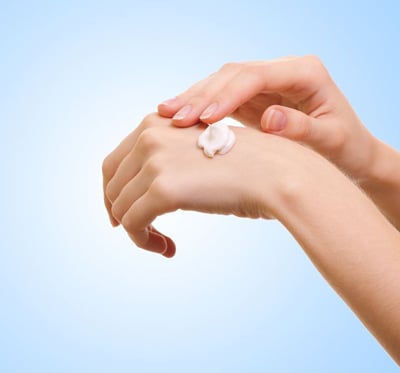 Multitasking emollients are ingredients that can both improve skin feel and provide other significant benefits. They can be used in formulations to thicken, provide shine, modify skin feel, help dissolve actives, increase skin hydration/elasticity/barrier function, and moisturize by reducing trans-epidermal water loss (TEWL). The key physical/chemical properties of emollients which determine their functionality include molecular weight, polarity, viscosity, freezing/melting point, surface tension, contact angle, and refractive index.
Multitasking emollients are ingredients that can both improve skin feel and provide other significant benefits. They can be used in formulations to thicken, provide shine, modify skin feel, help dissolve actives, increase skin hydration/elasticity/barrier function, and moisturize by reducing trans-epidermal water loss (TEWL). The key physical/chemical properties of emollients which determine their functionality include molecular weight, polarity, viscosity, freezing/melting point, surface tension, contact angle, and refractive index.
Emollients as moisturizing ingredients
Emollients can significantly improve the function of skin by different mechanisms, such as:
- Penetrating into stratum corneum epidermal lipids and modifying their crystallinity, resulting in reduced TEWL and increased hydration/elasticity
- Acting as pro humectants, which penetrate the stratum corneum and release humectant due to the presence of endogenous skin esterase enzymes.
- Up-regulating aquaporin 3 responsible for water homeostasis.
- Up-regulating skin tight junctions, desmosomes, and epidermal differentiation genes.
- Functioning as pseudo epidermal lipids to improve skin barrier function. They can mimic the functionality of epidermal lipids and augment natural epidermal lipids to help repair a defective barrier.
- Acting as perioxime proliferator activating receptors (PPARs). PPARs are fatty acid activated transcription factors that regulate lipid, glucose, and amino acid metabolism. No class of active I know can deliver as many different types of skin benefits as PPAR activators. Key benefits include improving skin barrier function, skin lightening, reducing wrinkles and improving skin texture
Looking for emollients for your skin care formulations?
Prospector has thousands of product listings for emollients. View technical data and request samples from a huge list of suppliers now.
Search Emollients
Recommended moisturizing emollients
- Isosorbide dicaprylate (HydraSynol DOI – Sytheon) stimulates aquaporin 3, e‐cadherin, claudins and desmosome proteins. It also works synergistically with glycerin to hydrate skin.
- C12-13 alkyl lactate (Cosmacol ELI – Sasol Performance Chemicals) has been shown to significantly reduce TEWL, reduce wrinkles, improve acne, reduce sebum, increase cell turnover, increase skin hydration, increase skin smoothness, and can act as a pro humectant.
- Di-C12-13 alkyl malate (Cosmacol EMI – Sasol Performance Chemicals) has been shown to significantly reduce TEWL, reduce wrinkles, improve acne, reduce sebum, increase cell turnover, increase skin hydration, increase skin smoothness, and can act as a pro humectant.
- PPG 15 stearyl ether (Arlamol PS15E – Croda) has been shown to increase both skin hydration and elasticity.
- Isostearyl isostearate (Crodamol ISIS – Croda) is very effective at reducing TEWL (better than petrolatum).
- Isopropyl isostearate (Crodamol IPIS) is effective at increasing skin hydration.
- Palmitamide MEA (Nikkol PMEA – Barnet Products) is a PPAR activator.
- Helianthus annuus (sunflower) seed oil unsaponifiables (Soline – Expanscience) is a PPAR activator that has been shown to stimulate epidermal lipid synthesis
- Hexyldecanol, bisabolol, cetylhydroxyproline palmitamide, stearic acid, and brassica campestris (rapeseed) sterols (SymRepair 100 – Symrise) has been clinically shown to protect and repair skin barrier function at .1%.
Emollients as solvents
Crystalline actives like salicylic acid, avobenzone and oxybenzone require high polarity emollients to solubilize them into the oil phase and prevent crystallization in formulations over time.
- PPG 15 stearyl ether (Arlamol PS15E – Croda) is an excellent solvent for salicylic acid, allowing for easy incorporation into the oil phase of an oil in water emulsion at 2%, without the use of high concentrations of solvents like Ethanol. It is also acid stable and can help reduce the irritation of the salicylic acid at low PH.
- Butylphthalimide isopropylphthalimide (Pelemol BIP PC – Phoenix Chemical) can dissolve up to 40% avobenzone and has a very low skin irritation potential.
- Dipropylene glycol dibenzoate (Finsolv PG22 – InnoSpec) can dissolve up to 37% oxybenzone and 29% avobenzone. It also claims to have similar skin moisturizing properties as petrolatum.
- Phenyl ethyl benzoate (X-Tend 226 –Ashland) can dissolve up to 35% oxybenzone and 24% avobenzone. It can also increase the lambda max of avobenzone-containing formulations to ~376 nm.
- PPG-3 benzyl ether ethylhexanoate (Crodamol SFX – Croda) can dissolve up to 18% oxybenzone and 18% avobenzone. It can also increase the lambda max of avobenzone-containing formulations to ~380 nm.
The views, opinions and technical analyses presented here are those of the author or advertiser, and are not necessarily those of ULProspector.com or UL Solutions. The appearance of this content in the UL Prospector Knowledge Center does not constitute an endorsement by UL Solutions or its affiliates.
All content is subject to copyright and may not be reproduced without prior authorization from UL Solutions or the content author.
The content has been made available for informational and educational purposes only. While the editors of this site may verify the accuracy of its content from time to time, we assume no responsibility for errors made by the author, editorial staff or any other contributor.
UL Solutions does not make any representations or warranties with respect to the accuracy, applicability, fitness or completeness of the content. UL Solutions does not warrant the performance, effectiveness or applicability of sites listed or linked to in any content.



Leave a Reply or Comment